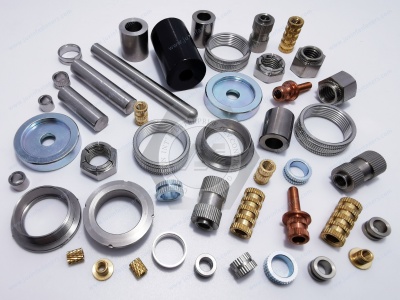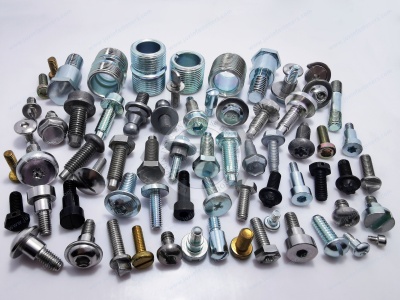Call Us
+86 136 6007 9809
Call Us
+86 136 6007 9809
Jun. 27, 2024
Fasteners with anti-loosening features and application precautions industry solutions
Fasteners with anti-loosening function in the actual application of the characteristics and precautions, including the commonly used anti-loosening form anti-loosening fastener characteristics and application precautions
These fasteners have a wide range of industrial production and daily life applications and are essential for improving product quality and safety.
Based on the fasteners with anti-loosening function in the fastening connection of the actual application process, as well as the anti-loosening effect of the test data, introduces its characteristics and its application of precautions, can be used by design engineers in the selection of anti-loosening measures and anti-loosening fasteners, as a reference.
For high-quality Carbon Steel Hexagonal Head Screws and professional technical support, don't hesitate to contact us at adelajonly@gmail.com or visit our website at: https://www.juxinfasteners.com.
The commonly used anti-loosening form and principle of introduction
In the fastener connection, there are four most frequently used forms of anti-loosening: friction anti-loosening, mechanical anti-loosening, destruction of threaded vice anti-loosening, and chemical bonding anti-loosening.
Among them, friction locking is the most widely used form because it is simple to use, easy to install, and has a high degree of standardization and repeatable use.
1.The principle of friction loosening: by letting the threaded connection between the vice always not with the external load and change the large enough positive pressure, to produce the friction to prevent the relative movement of the threaded vice, to achieve the role of anti-loosening.
Such as spring washers, self-locking nuts, and nylon self-locking nuts
2.Mechanical anti-loosening: using stop elements and direct locking to achieve the relative movement between the threaded vice and the limit. Because of the stop element and threaded fasteners' role on the surface, there is a particular gap. When the stopping effect occurs, the connection has occurred to a certain degree of loosening, so the effect of fastening anti-loosening almost only plays a role in preventing the fasteners from loosening.
3.The destruction of the threaded sub-loosening: This is in the fastener after tightening, through punch riveting, welding, and other forms, so that the threaded sub can not rotate loosening. This form of anti-loosening effect is good, but it has low assembly efficiency and no reusability. Therefore, in the case of large-scale, high-efficiency installation, it is rarely used.
4,Chemical bonding anti-loosening: this is through the pre-coated anaerobic adhesive or now coated in the form of anti-loosening adhesive, in the threaded sub-installation screwed into the form of pre-coated capsules, the formation of a certain degree of strength and toughness of the thermosetting plastics, filled with threads engaged in the gap, thus playing a role in restricting the rotational movement of the threaded sub to achieve the locking anti-loosening effect.
This form of anti-vibration, anti-loosening effect is good. While there is a certain sealing effect, under certain conditions, it can be reused, but disassembly is more difficult.
Features of threaded fasteners with anti-loosening function and application considerations


1. Bolts/screws
① Hexagonal flange bolts with teeth on the bearing surface
1)Features
The bearing surface of the bolt is covered with a specific angle "serrated" or arc-shaped teeth. In the process of tightening, the bearing surface of the compression force generated by the teeth embedded in the surface of the connecting parts increases the friction of the bearing surface of the bolt, thus playing an excellent anti-loosening effect.
(2) Application Notes
① Should not be used in combination with flat washers and spring washers;
② should not be used in connection with the hardness of the connected parts is higher than the minimum hardness of the bolt connection occasions;
③ When used in conjunction with nuts, self-locking nuts should be used as far as possible;
④ should not be used to connect the appearance of parts and the soft texture of the connected parts.
② Pre-coated anaerobic adhesive bolts/screws
1) Characteristics
Pre-coated anaerobic adhesive bolts have good anti-vibration and anti-loosening effects, and the threads have a specific sealing effect and can be applied under working conditions of -50~120℃. The shelf life of the adhesive is about two years, which is convenient for product storage. It is especially suitable for high locking requirements and infrequent disassembly occasions.
2)Application Precautions
① When assembling, try to fasten in place within 10 minutes;
② After tightening, should no longer be re-tightened;
③ When disassembling, if it is possible to use heating, try to disassemble after heating;
③ When disassembling, if heat can be used, try to disassemble after heating; ④ When the bolt is used for the second time, it should be assembled and fastened after cleaning the threaded hole and applying a small amount of anaerobic adhesive.
2.Nuts
① All-metal lock nuts
All-metal lock nut types mainly include hexagonal nuts, hexagonal flange nuts, hexagonal flange nuts, dodecagonal flange nuts, etc.
1) Characteristics
Through the deformation of the bottom hole of the internal thread or the deformation of the threaded teeth, when assembled and screwed with the bolt, it makes the threads produce an interference (interference) fit relationship, thus increasing the friction between the threads to achieve the role of anti-loosening.
Under vibration conditions, the anti-loosening reliability is high, and changing the material can be applied to working conditions under various temperatures. However, due to the role of metal deformation resistance, the nut deformation is more challenging to control, which leads to the anti-loosening torque dispersion being large, easy to assemble, and the phenomenon of biting dead. In addition, after assembly, due to friction, it is easy to damage the thread surface coating/plating layer, which affects the corrosion resistance.
2) Precautions for application
① When assembling, the speed of the assembly tool is not too high;
② For galvanized, Dacromet, and other surface treatment of the nut, assembly should be applied to the lubrication;
③ can be reused but can not be repeatedly installed more than five times.
② Non-metallic insert lock nut,
1) Characteristics
In the assembly process, the bolt threads will be naturally extruded into a screw thread on the nylon ring at the end of the nut to form a tight fit with the bolt threads, and at the same time, under the action of the elasticity of the nylon, friction is generated, thus playing a role in preventing loosening.
This kind of nut assembly torque is stable, but the anti-loosening effect is better. It can be reused, but the anti-loosening effect will be reduced. It can be used for shock vibration occasions. Compared with the all-metal lock nut, it will not damage the surface plating layer at the bolt thread.
(2) Precautions for application
① Not suitable for use in high-temperature conditions (its working range: -50 ~ 100 ℃);
② Not suitable for use in inorganic acid or strong alkali environment conditions;
③ During assembly, if the nylon ring is found to rotate, the nut should be replaced;
④ Can be reused but cannot be installed more than 20 times repeatedly;
⑤ Not suitable for nuts of grade 10 or above.
③ Slotted closing lock nuts
1)Features
In the assembly process, when the bolt is screwed into the nut, it automatically props up the end of the nut. Under the action of the deformation force of the nut closing, it makes the threads of the screwed parts form a close fit and, at the same time, produces a specific friction force, thus playing the role of anti-loosening. The torque of this kind of nut is stable. Still, the anti-loosening effect is good, can be reused by changing the material of the nut, and can be applied to various temperatures under working conditions.
2)Application Precautions
① When assembling, pay attention to whether there is a transverse crack at the closing point;
② When reused, pay attention to whether the closing part of the end of the nut has enough elasticity.
④ 30º wedge lock nut (Spirotech)
1) Characteristics
This type of nut is characterized by a 30º wedge-shaped angle at the bottom of the thread. When assembling and tightening bolts and nuts, the tip of the bolt teeth will be under the action of the wedge-shaped angle of the nut to form a sufficiently sizeable locking force, thus playing a role in preventing loosening. It has good anti-loosening performance, can be reused, and is especially suitable for various temperatures and shock vibration conditions. Still, it is not ideal for connecting the softer texture of the connectors. This thread structure, which can be applied to any nut structure and significantly improve efficiency, is currently the most widely used nut.
2)Application Precautions
① Before the use of Matching, it should be noted that the thread precision of the bolts should be 6g or six h, and the lower limit of the size of the large diameter can not exceed the difference;
② Matching before use, need to pay attention to the bolt threads with the tip of the serious decarburization phenomenon;
③ When assembling, the direction of assembly must be recognized;
When assembling, the direction of assembly must be recognized; ④ Care should be taken not to use too high a tightening speed when assembling;
⑤ The recommended assembly torque should be used during assembly.
⑤ Other types of locknuts
(1) Hexagonal flange face-bearing surface with teeth nuts
The characteristics of these nuts are the same as those of hexagon flange bolts with teeth on the bearing surface, but they cannot be used in combination with flat washers and spring washers.
2)Metal insert lock nuts
This type of nut and nylon lock nut characteristics are similar; it is in the end of the nut to increase the elasticity of a reed. When the bolt is screwed into the nut, the reed embedded in the nut will produce deformation, increasing the friction between the reed and the bolt threads, thus playing the role of anti-loosening. This type of nut has the characteristics of simple assembly, easy standardization, and reusability.
(3) Slotted nuts
This type of nut is used with cotter pins, mainly to limit the role of anti-loosening; it does not play this role. This type of nut has a simple assembly, but its efficiency is low. It is easy to achieve standardization and can be reused many times. In the assembly, pay attention to the cotter pin specification selection, which must meet the design requirements.
Contact Us
Tel.:
+86 020 8621 0320
+86 020 3121 6067
Technical Support:
Navigation
SEND INQUIREY